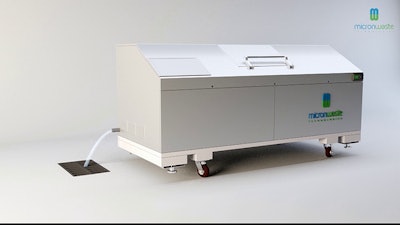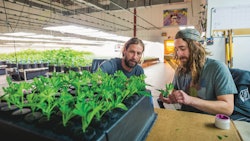
Micron Waste Technologies, a Vancouver-based organic waste technology company, began working with Aurora Cannabis in late 2017 to develop a waste solution specific to the cannabis industry, says Micron’s president, Alfred Wong.
Many regulatory, operational and environmental issues must be considered when dealing with cannabis waste. Canadian regulations mandate that cannabis producers render plant waste unusable. It must be mixed 50/50 with an organic medium—soil, cardboard or food waste, Wong says. (Many U.S. states have similar requirements.) If a cannabis producer wants to dispose of plant waste in a landfill or an outside compost facility, a senior person from the company must follow the truck to the landfill and watch the plants be destroyed. A past rule also mandated that the cannabis waste be kept in a vault during transit, although those regulations have since been relaxed. While composting is another option for on-site waste disposal, it requires both time and space to complete the process.
"Right now, in the industry, other solutions treat it as a food waste problem, thinking that cannabis, because it’s a plant, can go through the same process as other [materials], but we actually feel that that’s not the case,” Wong says.
Wong says an on-site waste treatment system can help cultivators avoid these time-consuming processes and reduce compliance risks.
Micron’s waste treatment system is two-fold, allowing cultivators to not only process waste on-site within 24 to 28 hours, but also to extract and clean the water.
“It extracts water from the waste and it cleans the water so that it meets sewage discharge standards, meaning that you can discharge the water safely down the drain,” Wong says. “It can also be used back into the agricultural process.”
Current Methods
Smaller cannabis producers have turned to composting to dispose of plant waste on-site, Wong says.
“Composting has been around for hundreds of years, and while the process works, it’s pretty intensive,” he says. “It needs to have a minimum of three days at a certain temperature in order to break down the cannabis residues. For it to be properly turned into compost, it needs anywhere between three weeks to three months, so you need to have a lot of space in your facility to be able to compost.”
When mixing cannabis plant waste 50/50 with an organic, the recommended and commonly used method is to mix the waste with kitty litter and dispose of it in landfills, he adds, as the deodorizing crystals mask the smell. The unpleasant smell associated with composting also deters some cultivators from embracing it to process their plant waste, he adds.
“From a regulatory perspective, it’s interesting because with the legalization that’s happening in Canada, the issue of waste handling has been ignored,” Wong says. “We really haven’t figured out what the proper way of doing is.”

A Two-Part System
The Micron Waste Technologies solution is comprised of two parts: a digestion system and a waste water treatment plant.
The digestion system uses a mechanical biological process, Wong says. Bacteria and enzymes break down the cannabis plant, and a grinding element also works to destroy the plant, which is very fibrous.
“That’s very, very different from other food waste like apples and oranges, where there isn’t really much pre-treatment that needs to happen,” Wong says. “But because it’s the cannabis industry, there needs to be a grinding element to reduce the plant down to a size where the microbes can start eating at it.”
The digestion system produces a slurry that is high in organic matter and contains cannabis compounds. This gets pumped into a 20-foot shipping container that houses the waste water treatment plant.
“Through our process, we’re able to remove and reduce a lot of the cannabis compounds, reduce organic matter, and at the same time … the result is … water that meets sewage bylaw standards,” Wong says.
Micron Waste Technologies has its own in-house research team, and the company’s founder, Bob Bhushan, has experience in wastewater treatment and has worked with the National Research Council of Canada (NRC), developing water remediation solutions.
The company chose an aerobic digestion process for its solution, which treats waste quickly and sustainably, Wong says.
“It was able to treat it very, very quickly, within 24 to 48 hours,” he says. “We’re able to mitigate a lot of the potential greenhouse gases that might be generated.”
Benefits to Cultivators
Treating waste on-site in an environmentally friendly way helps cannabis producers improve both sustainability and the branding of their product, Wong says. It also reduces the need to haul to landfills and allows the water to be reclaimed.
“And we recycle the water back into the environment, and that’s key, especially for states that have water security issues, like California,” Wong adds.
Not all organic waste treatment systems treat the water, leaving behind a dirty, smelly slurry that is discharged down the drain, he says. The municipal water system then must handle the waste, with taxpayers footing the bill.
“And every city, every municipality has sewage discharge standards,” Wong adds. “Every person or every business can’t just simply start dumping dirty water down a drain. So, from our perspective, to say we have a solution that treats the water as well, then the client, whether they’re a food waste producing industry or cannabis industry, they can have multiple uses for it. They can discharge it down the sewer legally and not get fined, or they can use it back into the agriculture operations.”
Aurora Cannabis and Commercialization
The first of several commercial-grade units will be delivered to Aurora Cannabis by June, Wong says. Micron Waste Technologies will work with Aurora to further develop the cannabis-specific solution, which will eventually be commercialized for other licensed producers.
Cam Battley, chief corporate officer at Aurora Cannabis, was one of Micron Waste Technologies’ early investors when Micron was just a private company and before Battley became chief corporate officer at Aurora, Wong says. Battley observed Micron’s technology in the food waste industry, and immediately saw an opportunity to fine-tune it for use in the cannabis space.
“[Battley] instantly saw the association of our solution, which we have proven the technology with the food waste industry, ” Wong says. “He saw the application with the cannabis industry, knowing the several issues that were surrounding cannabis cultivators at the time. That relationship started to cultivate, and it ended up with Aurora investing into Micron Waste, taking a 9.9-percent stake in the company with a $2 million investment, and that has really spring boarded the relationship, the research collaboration, between the two companies.”
Aurora has been able to help identify key factors needed in a cannabis waste solution, such as the ability to operate outside of the facility in any condition, even in subzero temperatures, Wong says.
“It’s important for us to be able to have a unit that could withstand harsh winter temperatures and having it outside was even more critical for Aurora because of the contamination issue,” he adds.
When a treatment system is inside and close to the grow rooms, there is a risk of contamination.
“It was apparent from day one that we needed to have it outside,” Wong says.
Many licensed producers like Aurora are also reliant on the waste treatment system expanding with them as they expand their facilities, he added.
“Many LPs are expanding their grow rooms, getting a lot of funding to expand operations in multiple jurisdictions,” he says. “and they need to have a secure and efficient way to grow with them, and that’s what we feel our solution does.”
Photos courtesy of Micron Waste Technologies

























